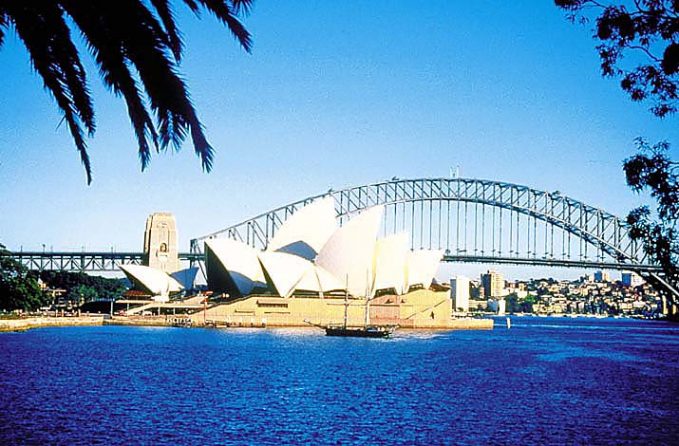
The adventurous spirit of the lone pioneer. Controlled by the Geographical Indications Committee, the formulation of designated wine regions -appellations - is well under way. Accurate labeling has become the standard. Let’s talk about the labels first. They are clear and informative these days. An Australian wine is named after the grape. If a single varietal is listed, it must contain at least 85 percent of that fruit. In a blend, the percentages of each variety must be printed. If the district is named, 85 percent of the wine must come from there. And if a vintage appears, 95 percent of the grapes must be from that vintage. The largest name on the label, however, identifies the producer. This is important, because while there are 900 wineries and over 4,000 wine grape growers in Australia, 80 percent of all wine goes to just a handful of giant companies. The best known are: – Lindemans, Penfolds (under Southcorp) And what about the grape varietals? Australia’s most important varieties grow in all the states. We’re talking young, young vines though. Chardonnay and cabernet didn’t even get introduced till the 70’s. Two thirds of Australian varietals are white: Riesling: More voluptuous and fragrant than elsewhere, but often with petrol tones. As for the reds: Shiraz: The Rhône varietal that’s named syrah in France: One of Australia’s first rootstock (with sémillon and riesling). Some Aussies still call it Hermitage, after the famous French town and wine. Peppery, smooth, textured, sexy, velvety or just plain dense. Grenache and mourvèdre, long-lost lovers from the Mediterranean, find their way into frivolous, refreshing rosés, serious seductive wines and easy-going table quaffers. Australia grows at least 20 other red varieties, including merlot, cabernet franc and malbec, and is currently experimenting with some Italian varietals, specifically sangiovese and nebbiolo. Here’s a closer look at the explosion of Australia’s winegrowing regions by state. Regions are known as geographical indications, the parallel to French appellations and American viticultural areas. For the time being, a wine’s origins may or may not have legal recognition, but that doesn’t say anything about quality. There are 40 distinct areas in more than 80 districts and subdistricts and as many or more separate microclimates. Of all wine produced, 95 percent is grown in the cooler regions of the three southern states — New South Wales, Victoria and South Australia. There is no such thing as a general weather pattern in the vast 3,000 miles of plateaus, maritime regions, mountainous elevations and warm inland valleys. Latitudes of these regions correspond to northern California and Oregon. NEW SOUTH WALES The warmest area overall, this state is home to Australia’s oldest wine region — the often cloud-covered and sometimes rainy Hunter Valley. New South Wales produces warm-climate robust reds, especially velvety/earthy shiraz, chocolate cabernets, full-bodied chardonnay and dignified Botrytis-sweet sémillon. Higher elevations are experimenting with cool-climate wines. Notable regions are: Hunter Valley, Mudgee, Riverina, and the emerging Canberra. VICTORIA This comparatively small, diverse state, tucked away in the southeast corner of Australia, hosts a range of cool maritime influences softened by more southern warmth. It comes out with intense, spicy shiraz wines in the Grampians and Central Victoria, elegant, fragrant pinot noirs in Yarra Valley and Geelong, and superb muscat dessert wines in Rutherglen. Other important regions are: Mornington Peninsula, Pyrenees and Goulburn Valley. SOUTH AUSTRALIA Australia’s most important wine producing state plays hard with its different soils and altitudes. Again, many different wines, from superb cabernets to minty, hefty shiraz and sexy wines made from sémillon and riesling. Also great sauvignon blanc, pinot noir and chardonnay. Cool, remote and southerly, Coonawarra, with its fertility of moist red dirt and limestone some have called obscene, is probably the most famous region, producing model cabernet. Just as important are the cool-climate regions of Clare Valley, with its 1,300 foot hills, Padthaway, Eden Valley, and the new vineyards of Koppamurra. Other notable regions are: Adelaide Hills, Riverland, McLaren Vale, Langhorne and Barossa, the oldest and most influential place. WESTERN AUSTRALIA New vineyards, experimenting with all the major varietals, are popping up across this state. From the warm Swann Valley come big reds. The temperate, oceanic-climate Margaret River produces sensational cabs and chardonnays. The cool Great Southern grows impressive slow-ripening riesling and sémillon. Newly defined Pemberton is coming out with remarkably subtle, seductive pinot noir. The coastal plain south of Perth has been renamed Geographe: it makes great wines, like the rest of the state, but government names (Geographe?!) sure take the romance out of the wine! TASMANIA The cold-climate island south of Victoria is another wine state not to be ignored. It shows great potential for excellent pinot noir, riesling, chardonnay and sparkling wines. QUEENSLAND AND NORTHERN TERRITORY Not too much is going on here. It’s hot and dry. In the Northern Territory, one single winery holds on, with pride and lots of irrigation. In Queensland, a few wineries struggle at higher altitudes. So what is the point? Australian wines — identifiable passion, sublime creativity — are cool. They’re affordable and they’re also six months ahead of us in terms of vintage. That means you don’t have to wait for next year’s tastings. (Keep that in mind if you want to be really out there and the first to pour a Y2K!) |




